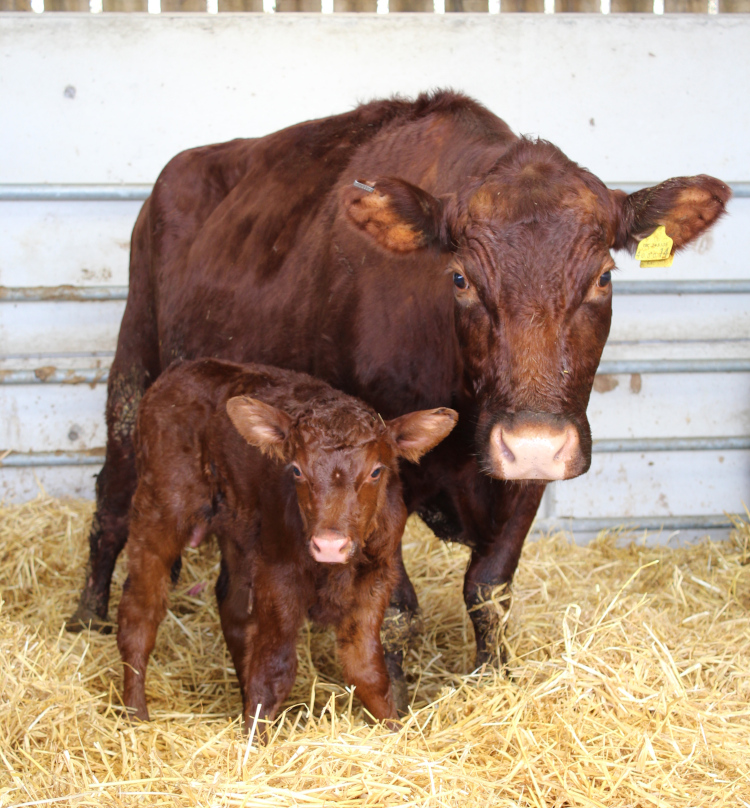Red Poll cow and calf

At this time of year we aim to be completely prepared for winter. All winter feed is in, water supplies are working and insulated against the coming frost, shed clean and tidy. For once I think we can tick all of those boxes. We put off the day when the herd comes indoors until the ground is so wet that the animals’ large weight supported by four quite small feet starts to damage the soil. This morning we brought in the cows and their calves and left everyone else out to munch on the last remaining grass and clover.
It’s at this time of year that Red Polls really earn their keep. Through spring and summer, feasting on lush pasture, most breeds will thrive. Now that the grass has stopped growing and everything edible is dying back ahead of the winter, the Red Polls should be able, not only to survive but gain weight. We don’t starve them of course! There’s still plenty of grass left from what was a very grassy summer. However, at this time of year it has a low nutrient content.
We’ve brought the cows in to wean their calves. By the time you read this the calves will be separated from their mums by a steel fence – still in nose to nose contact, but without access to milk. The calves would prefer not to be weaned, but by the time they have a huge, eight month old calf sucking on them, the cows really need a break, especially as they are all pregnant and need every last bit of energy to maintain themselves and build a new calf. Once they are inside, the cows and calves start eating expensive hay. So timing’s a balance for us.
There’s also the question of our neighbours. However and whenever we do it, both cows and calves make a lot of noise. But it’s mainly the calves. It’s a natural process which has to happen sometime; better our eight or nine months after birth than the two days that dairy calves get. The noise lasts about 36 hours and it is pretty loud. Very loud actually. Close up, a cow’s bellow is a rib cage shaking thing. We hope that for most within earshot, this noise is part of the deal of living in a rural village; a small price to pay for enjoying a herd of attractive cattle grazing fields that otherwise would be growing cereals or horses.
And then there’s Kingsley. We bought this young pedigree bull in May and pregnancy tests in summer showed he has done his job. He is now out with some young stock eating grass, but when they all eventually come in, he will start to receive a ration of bought-in feed in addition to ad-lib hay. He will need a bit of extra protein to grow to his full potential and ensure he is in peak condition for the task ahead next summer. So, we have bought some extra food for him. The rest of the herd are fed preserved grass in the form of hay which is cut, either on the farm or very nearby. This is supplemented by a lick that contains trace elements including calcium and magnesium – essential particularly for cows around the time of calving. When considering what feed to buy in for Kingsley, we wanted to make the least possible environmental impact. We have chosen an organic, British made feed, containing cereals and pulses, but without added soya or palm kernels. It has been difficult to find and is more expensive than most alternatives, but feels like the right move.
Another thing we’ve decided to do soon after housing is worm the young stock. We don’t worm routinely because the drugs used to kill intestinal parasites are expensive and persist in dung, then go on to lurk in the soil, killing other invertebrates that we would much rather thrived happily on the farm. Older cattle tolerate some intestinal worms but in young stock the worm burden builds up which causes a loss of condition. We monitor worms by a faecal egg count and only treat when recommended by the vet. The good thing about worming at housing in the autumn is that the drugs that pass through the animals’ gut and into the dung will lie in the shed and then in a heap, sometimes for more than a year and in that time the chemicals will break down and become inactive before the muck is spread on the fields to increase soil fertility.
Calves should start to appear in late February.
